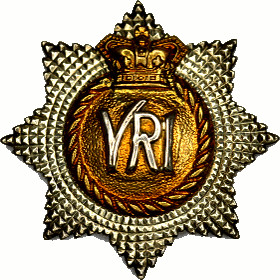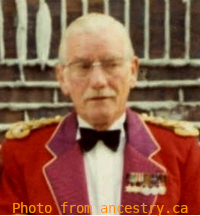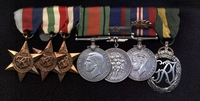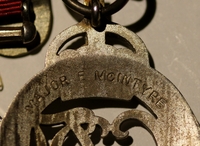
Lieut.-Col. Edward McIntyre, E.D.
The Highland Light Infantry of Canada
The Royal Canadian Regiment (C.A.S.F.)
The Perth and Waterloo Regiment (H.L.I. of Canada)
By: Capt (ret'd) Michael M. O'Leary, CD, The RCR
Edward McIntyre was born on 23 Feb 1906 in Glasgow, Scotland. His parents were James and Margaret Griffiths McIntyre.
McIntyre enlisted in the Glasgow University Contingent of the Senior Training Corps on 15 Jan 1924 at the age of 18 years 9 months. He had three years of previous service with the Hillhead High School Officer Training Corps (O.T.C.). McIntyre was discharged from the Glasgow University Contingent on 30 May 1928.
Emigrating to Canada in 1928, McIntyre crossed the Atlantic aboard the S.S. Athenia. His passage was paid by the Canadian Government in support of an intention to take up farm labour in Canada. The Athenia disembarked McIntyre at Quebec on 9 Jun 1928 with $15 in his possession. The ship's passenger manifest identified his initial destination as c/o The Salvation Army, Toronto, Ontario.
Three and one-half years after his arrival in Canada, McIntyre was appointed a Second Lieutenant in the 1st Battalion, Highland Light Infantry of Canada, at Galt, Ont., on 11 Dec 1931. Serving with the unit for six years, he was promoted to Lieutenant on 11 Dec 1933 and transferred to the Reserve of Officers on 27 Feb 1937.
Authorized at Berlin, Ont, on 14 Sepr 1866 as the 29th "Waterloo Battalion of Infantry," McIntyre's regiment was later renamed "29th Waterloo Regiment" in 1900, the "29th Regiment (Highland Light Infantry of Canada)" in 1915, and "The Highland Light Infantry of Canada" on 29 March 1920. It would eventually become the current regiment, The Royal Highland Fusiliers of Canada. In 1920, the H.L.I. of C. was reorganized as a two battalion regiment with the 1st Battalion (34th Battalion, CEF) as a unit of the Non Permanent Active Militia and the 2nd Battalion (111th Battalion, CEF) on the Reserve order of battle (Reserve units could have officers appointed but were not authorized to be manned). The two battalions were parenthetically titled for the regiment's perpetuated battalions of the Canadian Expeditionary Force. It was under this regimental organization that McIntyre was appointed to the 1st Battalion, H.L.I. of C. The Reserve battalion would be disbanded in 1936.
On 19 Jun 1934, Edward McIntyre married Margaret A. McDougall at Toronto, Ont. Born in Galt, Ont., Margaret was working as a nurse at the time of their marriage.
With the outbreak of the Second World Wear, McIntyre transferred from the Reserve of Officers back to the Active Militia on 24 Oct 1939. As a Lieutenant, he was appointed to "C" Company of the 1st Battalion, The Highland Light Infantry of Canada, at Galt, Ont. (which continued to retain its designation from the 1920 reorganization).
The Highland Light Infantry of Canada mobilized the "The Highland Light Infantry of Canada, C.A.S.F." (Canadian Active Service Force) for active service on 24 May 1940. This Active Force battalion was redesignated the "1st Battalion, The Highland Light Infantry of Canada, C.A.S.F." on 7 Nov 1940 and embarked for Britain on 20 Jul 1941. After three years in Britain, it would participate in the D-Day landings on 6 Jun 1944.
McIntyre, however, would not remain with the H.L.I. of C. Four months before the authorization of their Active Force unit, on 15 Jan 1940, McIntyre was granted a provisional appointment with the Regimental Depot of The Royal Canadian Regiment (C.A.S.F.). In the rank of Lieutenant with seniority in rank from 24 Oct 1939, he was appointed the Depot's Reinforcement Officer. Immediately on being taken on strength of The RCR Depot, McIntyre was posted to the Infantry (Rifle) Training Centre under No. 2 District Depot, Toronto, which was located at Camp Borden.
McIntyre's record of service documents note his training and qualifications as "Accountant, Bank Credit, Commercial Law, etc., from University of Toronto Extension." His next of kin was his wife, Mrs Margaret "Margo" Adamina McIntyre, 22 Blenheim Rd, Galt, Ontario. The couple had two children, Margaret (5 yrs) and John (1 yr 9 mos). McIntyre's religious denomination was Presbyterian. On his medical examination form, McIntyre was described as 5 feet 7 inches in height, with a 37-inch chest, weighing 138 pounds, with good physical development, a fair complexion, blue eyes, and blond hair.
On 7 Jun 1940, McIntyre's attachment to the C.I.(R.)T.C. Borden ceased and he returned (at least on paper) to The RCR Depot. His physical movement, however, was not to the Depot and he proceeding directly overseas as a reinforcement for The RCR (CASF). Depot records show him taken on strength for record purposes and struck off strength to proceed overseas on the same day.
On 9 Jun 1940, McIntyre was struck off the strength of the Canadian Army (Canada) and the following day shown as taken on the strength of the Canadian Army (Overseas). He disembarked in England on 21 Jun 1940 and joined No. 1 Canadian Infantry Holding Unit (C.I.H.U.).
While the cause is not noted in his files, McIntyre was in hospital from 28 Jun until 6 Jul 1940. Discharged, he was granted a few days sick leave from 6 to 8 Jul 1940.
On 28 Aug 1940, McIntyre was taken on the strength of The Royal Canadian Regiment and posted to "C" Company. His service with the Regiment in England was occasionally interrupted by training courses. McIntyre completed and was "Qualified Mortar Course" on 1 Mar 1941, after which he enjoyed a period of Privilege Leave from 12 to 19 Mar 1941.
In Aug of that year, he was again away for training. From 4 to 14 Aug 1941 McIntyre was attached to the Driving & Maintenance Course at the Polytechnical School, Croydon, in order to attend the Transport Officers' and Regimental Officers' Course.
McIntyre's experience with mortars was put to use on 5 Nov 1941 when he was attached to the Small Arms School for the 3-inch Mortar Course conducted 5-12 Nov 1941. The following month, on 5 Dec 1941, he proceeded On Command (i.e., a temporary duty assignment) as an Instructor at the 47 London Division School to instruct on the 3" Mortar Course. Accompanying McIntyre from the Regiment, to act as his batman while at the Division School, was A3367 Private W. Watt. McIntyre and Watt returned to unit lines on 20 Dec 1941.
On 13 Mar 1942, McIntyre was struck off the strength of The RCR and posted to the Canadian Training School (C.T.S.). He was an Instructor in 3 Wing at the School and to hold the rank of Acting Captain. While at the Training School, McIntyre's promotion was made substantive and back-dated to 5 Jan 1942. After six months with the C.T.S., he went on Privilege Leave from 7 to 14 Sep 1942.
Still belonging to 3 Wing C.T.S., McIntyre attended another course from 13 Oct 1942 when he was attached to the Small Arms School (S.A.S.) at Netheravon. The school had been at this location since 1922 and was known for conducting infantry heavy weapon courses.
McIntyre attended Course No. 1 in the 4.2" Mortar from 13 Oct 1942 to 12 Nov 1942 and Qualified "Q2." Notes on his assessment for the course included:
"His ability as an instructor is very fair. His general knowledge of the weapon is fair.
"He has worked hard and has a very fair knowledge of the weapon. He requires more practical experience, both in observation of fire and in the handling of mortars in the field. Given this he should prove a capable instructor."
Late on the evening of 5 Dec 1942, McIntyre had an accident while bicycling from Passfield to Conford village. Found unconscious on the road, he was examined at 15 Cdn. General Hospital and then transferred to No. 1 Neurological Hospital at Basingstoke. On admission to hospital, his attachment to 3 Wing C.T.S. was terminated and he was transferred on paper to No. 1 Canadian Division Infantry Reinforcement Unit (C.D.I.R.U.).
While McIntyre was in hospital, a Court of Inquiry was convened by C.W. Devey, Colonel, Ld.S.H., Commandant C.T.S., to examine the circumstances of his accident. The President and Members of the Court met on 17 Dec 1942 and heard from three witnesses, including McIntyre.
"1st. Witness – Capt. E. McIntyre - R.C.R./C.T.S., having been duly sworn stated::—
"On Saturday 5 December 1942, at about 2250 hrs., I was bicycling from Passfield to Conford village. During this time I met with an accident, the facts of which I do not remember. The only thing I do remember, was when I regained consciousness in No. 1 Neurological Hospital, Basingstoke, three days later. I apparently had been thrown from my bicycle, and landed in the middle of the road. I understand I was taken to No.15 General Hospital, Bramshott by Capt. J.A. Hilliard - R.C.A., H.Q. "C" Group C.R.U. thence to No. 1 Neurological Hospital, Basingstoke by ambulance."
"2nd. Witness Capt. J.A. Hilliard - R.C.A., H.Q. "C" Group, C.R.U. having been duly sworn stated:—
"On the night of the 5 December 1942, I was bicycling from Passfield to Conford village in company with Capt. E. McIntyre. On reaching the First Aid Post at Conford village, I noticed that Capt. McIntyre was not with me. I turned around and went back to look for him. I found Capt. McIntyre on the road at map reference 261527 (Aldershot Command Sheet). I examined Capt. McIntyre who was unconscious and found him to have an injured ear, I carried Capt. McIntyre to the side of the road and returned to the First Aid Post for assistance. We carried Capt. McIntyre to the First Aid Post, and called an ambulance from 15 Cdn. General Hospital. I notified the Orderly Officer at Cdn. Training School that Capt. McIntyre was in 15 Cdn. General Hospital. The following morning I called 15 Cdn. General Hospital and was informed that Capt. McIntyre was in 1 Cdn. Neurological Hospital, Basingstoke."
"3rd. Witness. Capt. A.W. Bagnall – R.C.A.M.C., 15 Can. General Hospital, having been duly sworn stated:—
"Capt. E. McIntyre, R.C.R./C.T.S. was seen by me in the Admitting Dept. of No.15 General Hospital R.C.A.M.C. on the night of 5 December 1942 about 2500 hrs. I checked him over and could find no serious injury apart from the head. He was unconscious and could not be roused, and I therefore sent him to No. 1 Neurological Hospital, which is the custom in such cases. There was a small scalp laceration involving the ear. I found no evidence of serious I injury at the time. I cannot give evidence as to whether or not he had been drinking in excess, though his general appearance would make me think that he had not been."
The court found "no negligence on the part of Capt. E. McIntyre, when he met with his accident. He apparently was knocked off his bicycle by some person unknown, of, came in contact with some obstacle lying on the highway." This finding was supported by the Commandant of the C.T.S., the Brigadier Commanding "F" Group, Canadian Reinforcement Units (C.R.U.), and the Brigadier Commanding C.R.U.
On 29 Dec 1942, McIntyre was discharged from 1 Neuro Hosp., and returned to the C.T.S. Medical notes from the hospital identified three diagnoses: (1) Laceration of right ear, (2) Cerebral concussion, and (3) Fracture of right maxilla. On discharge his Precis Case History read: "Patient admitted in semi-conscious state and soon was able to talk and cooperate with examination. Neurological examination revealed nothing noteworthy but x-rays snowed a fracture of right maxilia into antrum and he had a severe laceration of his right ear, the upper attachments of which were badly torn, revealing cartilage. Under pentothal anaesthesia this was carefully debrided and sutured. Convalescence was uneventful apart from slight drowsiness for a couple of days. Pre-trauma amnesia 10-20 mins. Post-trauma amnesia 30 hours."
Two days after his discharge from hospital, on 31 Dec 1942, McIntyre proceeded on the Junior Staff Course No. 4 at the Staff College. His course was completed on 20 Mar 1943. McIntyre's overall assessment was a "D" and his abilities in most areas were considered average with his knowledge of his own arm of the service noted as above average. McIntyre's written assessment, signed by Lieut-Col P. St. Clair Ford of the Directing Staff, read: "He has not a great deal of mental ability, but he is practical and has a good knowledge of infantry work. He is not good on paper, but is not afraid to express his opinions verbally. He seems more suitable for Regimental duty than for staff work. If, however, he is employed on the staff he should be given a 'G' appointment." McIntyre's suitability for employment, in priority, was listed as (1) 3rd Grade G (GSO III), (2) Q Branch, (3) A Branch, and (4) "He is suited to serve with troops."
Brigadier W. Goschen, the Assistant Commandant at the Staff College, concurred with McIntyre's assessment: "I agree. He is not really suited to staff work; he is very weak on paper. His opinions are usually sound, especially on problems connected with his own arm. He is capable of doing a third grade G appointment. His comparative lack of success is not for want of trying. He is a very pleasant officer to deal with."
On 2 Apr 1943, McIntyre returned to 3 C.I.R.U. from the Junior Staff Course. Two weeks later, on 15 Apr 1943, he was posted back to The RCR.
The Regiment's War Diary offers a look at the activities of the Regiment in mid-April 1943:
"15 April 1943 – Field, Hampden Park
"N.C.O.s.day— a day which all possible N.C.O.s were trained together, under the direction of the Commanding Officer Lt.-Col. R.M.Crowe. The "I" section concluded their recce of the Battalion anti-raid area of responsibility, and submitted their findings re defence of BIRLING GAP 9814 9915 and FRISTON AIRDROME 9616 to 1 Cdn. Inf. Bde.
"Weather: Clear, cool.
"16 April 1943 – Field, Hampden Park
"Officer's day. At 0900 hrs the Officers of the Regiment moved out to the HAILSHAM AREA and spent the morning making a thorough recce of the location and condition of existing Infantry defence works in the Battalion area of responsibility to counter invasion. At 1415 hrs the Officers had the first of a series of refresher drill parades under (W.O. I) R.S.M. McDonnell. The afternoon was spent in a recce and preparation for exercise TOULON, the defence of RAF BEACHY HEAD. Training during the day was under Coy. arrangements.
"Weather: Clear and warm.
"17 April 1943 – Field, Hampden Park
"This being Saturday the O.R.s of the Battalion paraded under the RBM for ceremonial drill and this was followed by the routine kit and billet inspection. At 123O the Commanding Officer Lt.-Col. R.M. Crowe liaised with F/O Lewis, Commanding RAF BEACHY HEAD, and completed arrangements for exercise TOULON. The afternoon was free.
"Weather: Clear, cool."
Soon after, the Regiment's primary focus would be preparation for the upcoming landings in Sicily. On 29 Jun 1943, McIntyre was taken on the strength of the Canadian Army (Mediterranean) when he sailed from British shores in the invasion fleet. McIntyre did not sail for the landings in Sicily with the main body of the Regiment aboard the Marnix Van St. Aldegonde. He was on another ship, likely as a selected "Left Out of Battle" (L.O.B.) officer separated from the unit during the initial landing operation. The L.O.B. system ensured that a small group of regimental officers, N.C.O.s, and soldiers would remain as a core around which a unit could be rebuilt with reinforcements if operations took a tragic turn.
McIntyre disembarked on the shores of Sicily on 13 Jul 1943, three days after the main landing, to take up his role in command of the Regiment's Mortar Platoon. His second-in-command, Lieut, T.H. Burdett, had landed with the platoon on 10 Jul 1943. As recorded in the War Diary, the Regiment's progress over the following week as it advanced through the Sicilian countryside continued, was recorded as:
- 13 Jul 1943 – Giarratana
- 15 Jul 1943 – Vizzini, Grammichele
- 16 Jul 1943 – Caltagirone
- 18 Jul 1943 – Valguerna
- 20 Jul 1943 – Assoro
One week after landing, on 20 Jul 1943, McIntyre was struck off the strength of the Regiment to the RCR X-3 List on admission to 4 Canadian Field Ambulance. The X-3 List held the names of personnel who were injured or wounded and evacuated to a Casualty Clearing Station behind the lines (or further to the rear), i.e., not a forward aid station.
On 23 Jul 1943, McIntyre was admitted to 3 Casualty Clearing Station (RAMC) and transferred the same date to 200 Field Ambulance (RAMC). Two days later, on 25 Jul 1943, he was admitted to 48 General Hospital (RAMC) at Tripoli, with a lacerated left knee.
After more than two weeks in the General Hospital, McIntyre was transferred to No. 7 Convalescent Depot on 11 Aug 1943. Nearly a month later, on 7 Sep 1943, he was admitted to the Canadian Medical Rest Centre which at this time was south of Catania on the east coast of Sicily. The Rest Centre, or Rest Station, was an ad hoc unit established to minimize the evacuation of minor medical cases and was under the control of No. 1 Canadian Base Reinforcement Unit. On 12 Sep 1943, McIntyre was transferred from the Rest Centre to the RCR X-4 List, 4 Bn. The X-4 List held unposted reinforcements in readiness to join front line units. The expansive nature of the reinforcement challenge is shown by its organization into "battalions" for administrative control.
On 14 Sep 1943, McIntyre was detached from the RCR X-4 List. He did not return to The RCR but was attached to No. 1 Canadian Public Relations Unit. This attachment ceased on 4 Jan 1944 when he was formally taken on the strength of 1 Cdn P.R. Unit.
McIntyre transferred from 1 Cdn P.R. Unit to 2 Cdn P.R. Unit on 29 Mar 1944. Four months later, on 5 Aug 1944, he was appointed to command a Field Section of 2 Cdn P.R. Unit and was promoted to Acting Major while so employed.
On 10 Nov 1944, McIntyre was appointed Deputy Assistant Director of Public Relations. Later that month, on 27 Nov 1944, he was transferred to the General List from the list of officers of the Canadian Infantry Corps (CIC).
McIntyre's majority was made substantive on 5 Feb 1945. Less than a week later, on 11 Apr 1945, he disembarked in North West Europe and shortly after was struck off the strength of 2 P.R. Group and transferred to to 3 P.R. Group.
In a 2009 PhD dissertation, T.J. Balzer describes the role of No. 3 Canadian PR Group: "For Canadian Army Public Relations (PR), the Northwest Europe Campaign was also the major effort of the war. No. 3 Canadian PR Group, the largest Canadian PR formation deployed in warfare, escorted and housed correspondents, censored news copy, photographed combat, performed liaison duties with Supreme Headquarters Allied Expeditionary Force (SHAEF), and even operated loudspeaker units attempting to induce German troops to surrender." (Balzer's dissertation also mentions McIntyre and other P.R.O.s in Italy who, during a lull in operations, sat for life-size pastel portraits by the Italian artist Federico Spoltore at Lanciano (south of Ortona) in April, 1944.)
Shortly after the end of hostilities in North West Europe, McIntyre was granted 11 days Privilege Leave in the United Kingdom from 1 to 12 Jun 1945. Less than two weeks after his return to duty on the continent, he returned to the UK on 25 Jun 1945, the first stage of his homeward journey. Arriving at No. 1 Canadian Reception Depot (UK) on 4 Jul 1945, McIntyre was immediately struck off strength to No. 1 Canadian Repatriation Depot. On 16 Jul 1945 he was struck off the strength of the Canadian Army (Overseas) and the following day embarked for Canada.
A careful reading of McIntyre's service record reveals the reason behind his quick repatriation to Canada becomes clear. On 18 Jul 1945, he was taken on the strength of the Canadian Army Pacific Force and posted to the X-4 List (Gen List), then posted to X-10 List (i.e., reinforcements for special employment) and attached for all purposes to C.A.P.F. Base HQ.
On 23 Jul 1945, Edward McIntyre disembarked in Canada. He was granted 30 days special leave from 25 Jul to 23 Aug 1945 plus 4 days travelling time with 30 days money allowance in lieu of rations. This was one of the offered perks for those personnel who volunteered for the Pacific Force.
Soon after his return from leave, on 5 Sep 1945, McIntyre was struck off the strength of now unneeded C.A.P.F. and transferred to A-1 Canadian Army Training Centre. This change of administering unit must have been accompanied by McIntyre continuing in a Public Relations appointment. On 29 Sep 1945, The RCR returned from Europe on the Netherlands liner Nieuw Amsterdam. The ship docked at Halifax on 29 Sep 1945 and the regimental history notes that Major E. McIntyre was among the welcoming party.
It was not until 23 Oct 1945 that McIntyre's connections to the C.A.P.F. base HQ were completed ended and he was posted to No. 9 District Depot, C.A., at Ottawa, Ont. Caught up in the rapidly changing organizations of the post-war Army, McIntyre was attached to N.D.H.Q. on 24 Oct 1945 and attached to the Directorate of Public Affairs (Army) N.D.H.Q.. Six days later, on 30 Oct 1945, he was taken on the strength of the HQ Military District No. 6 in Halifax, N.S. Filling the appointment of Public Relations Officer for the Military District , McIntyre was attached for rations to HQ Fixed Defences, East Coast, and drew an allowance in lieu of quarters.
With the award announcement appearing in the Canada Gazette on 3 Nov 1945 and the London Gazette, issue No. 37433, dated 17 Jan 1946, Edward McIntyre was awarded a Mention in Despatches for his service in the Second World War. His C.A.S.F. citation card provides the stock paragraph "The KING has been graciously pleased to approve the award of Mentions in Despatches in recognition of gallant and distinguished services, to:" Following this is the single hand-written word "Italy."
On 20 Feb 1946, McIntyre was in New York City to execute responsibilities as Officer Commanding, Public Relations Party. On that date, the troopship R.M.S. Queen Elizabeth docked at Pier 90, New York City. The ship was carrying her last contingent of Canadian troops to North America.
In early 1946, McIntyre became eligible for the Canadian Efficiency Decoration, the long service award for officers of the Canadian Militia. On 15 May 1946, this medal was sent to the District Officer Commanding, Military District, No. 6, Halifax, N.S., for presentation.
McIntyre vacated the appointment of P.R.O. at M.D. No. 6 on 30 Jun 1946. He was struck off strength to No. 1 District Depot in London, Ont., which would manage his release, but remained in Halifax, attached to H.Q. M.D. No. 6 until 16 Jul 1946. Finally on his way home after his wartime service, McIntyre was granted seven days pre-retirement leave from 22 to 28 Jul 1946.
On 29 Jul 1946, McIntyre was struck off the strength of the Canadian Army (Active Force) and placed on the Reserve of Active Officers, General List. On that same day, he was interviewed by a Veterans Affairs counsellor at No. 1 District Depot to determine his suitability for and to make recommendations for future employment. Excerpts from the counsellors notes follow:
"Pre-Enlistment Education:— Equivalent of Junior matric in Scotland 1921, completed extramural course with U. of T. in Can. Credit Institute course; accountancy, Band Credit, Business English.
"Occupational History:— 1921-27; employed as office clerk with decorator's merchants, Scotland. 1928-34; assistant purchasing agent for engineer supply firm Galt. Ont.
"Pre-Enlistment Employment:— 1934-39 employed as district representative for decorators merchants James McIntyre and Sons, 25 Newton Place, Glasgow Scotland
"Service, Training and Duties:— Total service of approx 17 months in Canada and 61 months in U.K., Italy, and N.W.E. Enlisted at Lieut, Capt Jan 42, Maj 5 Aug 44. Regimental officer in CIC until July 45; employed with Public Relations service since that time (Mentioned in Despatches).
"Dischargee's Own Statement Of Future Plans (If Any):— "My plans are indefinite as my employers in Scotland have temporarily suspended active business operation due shortage of materials."
"Basis For Counsellor's Recommendations:— Major McIntyre reports that his firm in Scotland are, at the present time, unable to obtain sufficient supplies for normal trade. It is expected that from one to two years will again see the firm operating at normal capacity. He then purposes returning to his former employment. In the meantime Major McIntyre hopes to obtain temporary employment in Canada as purchasing agent, preferably for D.V.A., or sales promotion work with some advertising or industrial firm. Major McIntyre hes a good background for employment in the fields he suggests., It should also be noted that considerable of his army service was in public relations work at Army H.Q. level. His particular appointment was Officer Commanding Field Detachment, Public Relation in Italy and, on vacating the appointment, was deputy assistant director Public Relations Officer for the Canadian army in Italy.
"Action Recommended:— Classification: Seek employment. Recommendation: Employment as purchasing agent or sales promotion representative.
"Other Possibilities Suggested By Counsellor:— Re-employment as district representative for decorators merchants."
For his operational service in the Second World War, McIntyre received the 1939-45 Star, the Italy Star, the France & Germany Star, the Defence Medal, the Canadian Volunteer Service Medal with Overseas Clasp, and the 1939-45 War Medal. In addition, he received his Mention in Despatches oak leaf emblem worn on the War Medal. McIntyre also received a war service badge for wear on his lapel in civilian dress.
Major Edward McIntyre returned to service on 15 Mar 1950 when he was attached to the Highland Light Infantry of Canada from the Supplementary Reserve. At the time of his reactivation from the Supp. Res., he was employed as a Purchasing Agent for the Galt Metal Industries Ltd. It was not until 1 Sep 1950 that he was formally struck from the Supp. Res. and taken on the strength of the regiment as Second in Command.
On 31 Jul 1953, McIntyre relinquished the appointment of 2IC of the HLI of C. The following day he was promoted to Acting Lieutenant Colonel and appointed Commanding Officer.
McIntyre relinquished the appointment of CO, H.L.I. of C. on 30 Sep 1954 and was struck off strength to the Perth and Waterloo Regiment (Highland Light Infantry). On 1 Oct 1954, The Highland Light Infantry of Canada was amalgamated with The Perth Regiment and redesignated "The Perth and Waterloo Regiment (Highland Light Infantry of Canada)." This amalgamation was short-lived. On 1 Apr 1957, it was reversed and the two regiments resumed their former designations.
While commanding the amalgamated regiment, McIntyre's rank of Lieut.-Col. Was made substantive on 1 Aug 1955. The following day, on 2 Aug 1955, he relinquished the appointment of CO and was transferred back to the Supplementary Reserve. His status changed again on 23 Feb 1966 when he was released from the Supp. Res. and placed on the Retired List.
In retirement, McIntyre's name appears in The RCR Association membership list published in the regimental journal Pro Patria, Issue 26, Nov 1975, where he is shown as LCol E. McIntyre, 40 James St., Cambridge-Galt, Ont. By 1979, his address is 17 Lansdown St. N., Cambridge, Ont.
Edward McIntyre died on 24 Dec 1982 at Cambridge, Ont. He is buried in Mountain View Cemetery in Cambridge alongside his wife Margaret (1905-1968).
Pro Patria
Visit a randomly selected page in The O'Leary Collection (or reload for another choice):
- The O'Leary Collection; Medals of The Royal Canadian Regiment.
- Researching Canadian Soldiers of the First World War
- Researching The Royal Canadian Regiment
- The RCR in the First World War
- Badges of The RCR
- The Senior Subaltern
- The Minute Book (blog)
- Rogue Papers
- Tactical Primers
- The Regimental Library
- Battle Honours
- Perpetuation of the CEF
- A Miscellany
- Quotes
- The Frontenac Times
- Site Map
QUICK LINKS
The O'Leary Collection—Medals of The Royal Canadian Regiment
Newest additions:
![]()
![]() SB-12725 Private Henry "Hank" Ard
SB-12725 Private Henry "Hank" Ard ![]()
WIA at Hill 187, Died of Wounds in Japan
![]()
![]() 2355331 Lance Corporal Albert Lorking
2355331 Lance Corporal Albert Lorking
Wounded in action, later a War Amps representative.
![]()
![]() 4334 / 477996 Pte Isaac Hamilton Wilcox
4334 / 477996 Pte Isaac Hamilton Wilcox
Permanent Force, South Africa, and C.E.F.
![]()
![]() 477019 Private Harold Ashcroft
477019 Private Harold Ashcroft
Transferred to the Tunnelers.
![]()
![]() 734231 Private Clark D. Thompson
734231 Private Clark D. Thompson ![]()
The older Thompson brother, killed in action.
![]()
![]() 733849 Private Norman Parker Thompson
733849 Private Norman Parker Thompson
The younger Thompson brother; post-war service in the Special Guard.
![]()
![]()
![]() A305 / 400305 Private Andrew Walker
A305 / 400305 Private Andrew Walker ![]()
"Previously reported Wounded, now Killed in Action."
![]()
![]() 823298 Pte Thomas Patrick Steele, M.M.
823298 Pte Thomas Patrick Steele, M.M. ![]()
… for gallant conduct in the field …
![]()
![]() P13066 Sergeant Harold Thompson
P13066 Sergeant Harold Thompson
Instrumental Soloist for over 20 years of Canadian Army service.
![]()
![]() 9609 / 477728 Private Albert Edward Piper
9609 / 477728 Private Albert Edward Piper
"Arrived from England as a STOWAWAY …"





